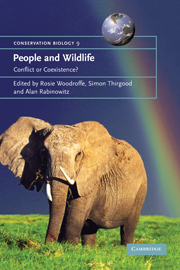Book contents
- Frontmatter
- Contents
- List of contributors
- Foreword
- Acknowledgements
- 1 The impact of human–wildlife conflict on natural systems
- 2 The impact of human–wildlife conflict on human lives and livelihoods
- 3 Characterization and prevention of attacks on humans
- 4 Non-lethal techniques for reducing depredation
- 5 Techniques to reduce crop loss: human and technical dimensions in Africa
- 6 Evaluating lethal control in the management of human–wildlife conflict
- 7 Bearing the costs of human–wildlife conflict: the challenges of compensation schemes
- 8 Increasing the value of wildlife through non-consumptive use? Deconstructing the myths of ecotourism and community-based tourism in the tropics
- 9 Does extractive use provide opportunities to offset conflicts between people and wildlife?
- 10 Zoning as a means of mitigating conflicts with large carnivores: principles and reality
- 11 From conflict to coexistence: a case study of geese and agriculture in Scotland
- 12 Hen harriers and red grouse: the ecology of a conflict
- 13 Understanding and resolving the black-tailed prairie dog conservation challenge
- 14 People and elephants in the Shimba Hills, Kenya
- 15 Safari hunting and conservation on communal land in southern Africa
- 16 Socio-ecological factors shaping local support for wildlife: crop-raiding by elephants and other wildlife in Africa
- 17 Jaguars and livestock: living with the world's third largest cat
- 18 People and predators in Laikipia District, Kenya
- 19 Searching for the coexistence recipe: a case study of conflicts between people and tigers in the Russian Far East
- 20 A tale of two countries: large carnivore depredation and compensation schemes in Sweden and Norway
- 21 Managing wolf–human conflict in the northwestern United States
- 22 Policies for reducing human–wildlife conflict: a Kenya case study
- 23 An ecology-based policy framework for human–tiger coexistence in India
- 24 The future of coexistence: resolving human–wildlife conflicts in a changing world
- References
- Index
15 - Safari hunting and conservation on communal land in southern Africa
Published online by Cambridge University Press: 23 November 2009
- Frontmatter
- Contents
- List of contributors
- Foreword
- Acknowledgements
- 1 The impact of human–wildlife conflict on natural systems
- 2 The impact of human–wildlife conflict on human lives and livelihoods
- 3 Characterization and prevention of attacks on humans
- 4 Non-lethal techniques for reducing depredation
- 5 Techniques to reduce crop loss: human and technical dimensions in Africa
- 6 Evaluating lethal control in the management of human–wildlife conflict
- 7 Bearing the costs of human–wildlife conflict: the challenges of compensation schemes
- 8 Increasing the value of wildlife through non-consumptive use? Deconstructing the myths of ecotourism and community-based tourism in the tropics
- 9 Does extractive use provide opportunities to offset conflicts between people and wildlife?
- 10 Zoning as a means of mitigating conflicts with large carnivores: principles and reality
- 11 From conflict to coexistence: a case study of geese and agriculture in Scotland
- 12 Hen harriers and red grouse: the ecology of a conflict
- 13 Understanding and resolving the black-tailed prairie dog conservation challenge
- 14 People and elephants in the Shimba Hills, Kenya
- 15 Safari hunting and conservation on communal land in southern Africa
- 16 Socio-ecological factors shaping local support for wildlife: crop-raiding by elephants and other wildlife in Africa
- 17 Jaguars and livestock: living with the world's third largest cat
- 18 People and predators in Laikipia District, Kenya
- 19 Searching for the coexistence recipe: a case study of conflicts between people and tigers in the Russian Far East
- 20 A tale of two countries: large carnivore depredation and compensation schemes in Sweden and Norway
- 21 Managing wolf–human conflict in the northwestern United States
- 22 Policies for reducing human–wildlife conflict: a Kenya case study
- 23 An ecology-based policy framework for human–tiger coexistence in India
- 24 The future of coexistence: resolving human–wildlife conflicts in a changing world
- References
- Index
Summary
INTRODUCTION
Safari hunting, sometimes called tourist hunting, is a form of land use that is capable of generating exceedingly high market value for wildlife resources. Well-established trade practices exist worldwide for marketing hunts to maximize the economic value of wildlife, and to satisfy tourist demand for hunting adventures and trophy quality animals. Revenues from these sales account for over US$500 million annually worldwide, and in South Africa alone, annual revenues exceed US$50 million (Van der Walt 2002). The direct revenue to the government of Tanzania from safari hunting exceeds US$10 million annually (E. Severre pers. com.).
On private land, tourist hunting has become a major factor for wildlife recovery and reintroduction in many parts of the world. Examples of these successes are in the tens of thousands and have unequivocally proven to be an important economic engine for conservation. In South Africa, for example, over 9000 private game ranches occupy 10 364 km2 (Bothma 2002), and have contributed to the recovery of blesbok (Damaliscus albifrons), white rhinoceros (Ceratotherium simum), black wildebeest (Connochaetes gnou) and the Cape mountain zebra (Equus zebra zebra) (Flack 2002). Today, South Africa has more wildlife than it has had in the past 100 years (Bothma 2002). It is estimated that game ranches in South Africa contain 1.7 million large mammals on 13.3% of the land formerly designated for agriculture, but subsequently converted to private game ranches (Eloff 2002).
- Type
- Chapter
- Information
- People and Wildlife, Conflict or Co-existence? , pp. 239 - 251Publisher: Cambridge University PressPrint publication year: 2005
- 12
- Cited by



